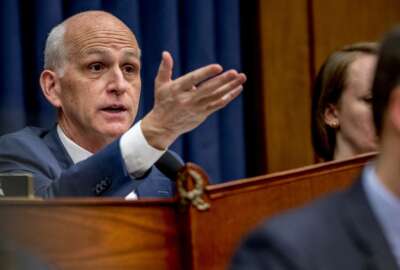
DoD's chief management officer has found $11 billion in cost reductions this year, but the office's continued existence is in doubt.
A new review of spending and operations within the Defense Department’s “fourth estate” has yielded $11 billion in cost reductions, with another $6.5 billion more still under review, according to the senior Defense official the Pentagon tasked to lead the effort earlier this year.
Lisa Hershman, DoD’s chief management officer, said the bulk of those savings flowed from sustainable, long-term business reforms — not one-time budget cutting exercises.
In an interview, she said they happened largely because Defense Secretary Mark Esper empowered the CMO’s office to direct management reforms in the portions of the Pentagon bureaucracy outside the military services when, in a January memo, he tasked Hershman to take a deeper dive into the operations of the fourth estate and develop its first-ever consolidated budget plan.
“That memo put some teeth behind this role. The secretary said, ‘I want the CMO to essentially become secretary of the fourth estate,’” she said in a wide-ranging interview on Federal News Network’s On DoD. “Since then, we’ve had a huge turning point. One of the things that I have been championing is replacing across-the-board cuts with reforms. And within the past couple of months, I’ve had [Defense agency] leaders saying to me, ‘Lisa, when do we get a reform package from you?’ They want that as an alternative to cuts.”
Asked for examples of the reform initiatives that have delivered payoffs in lieu of budget reductions, Hershman pointed to improved contract management within the Defense agencies and field activities, and in particular, a new initiative to implement category management practices across those agencies.
“We have about 45,000 contracting officers, and they’re all looking at contracts for commodities like a battery. We had multiple contracts for the same battery, and the price points ranged from 13 cents to $25 per unit,” she said. “This gives us an enormous opportunity to look at how we’re managing contracts, and whether we can do a better job and save money. The answer is yes. In one of the agencies that [was considering] an across-the-board cut, we looked at six of their largest contracts, and if we just renegotiate those and leverage our buying power, we actually are able to realize more savings than we would with the across-the-board cut.”
The CMO’s office is trying to make the case that it’s had some early successes in driving business transformation at a time when Congress appears to have already convinced itself that the opposite is true.
In the 2020 National Defense Authorization Act, lawmakers opined that DoD has “faced significant structural challenges in implementing the Chief Management Officer position since its inception,” and signaled their intention to do away with the office altogether.
Both the House and Senate versions of the 2021 bill would do just that, though their approaches to disestablishing the position — currently the third-highest ranking job in the department — are quite different from one another, and would have to be resolved in a conference committee later this year.
The CMO office, in its current form, has only existed since February 2018, a date Congress set when it first created the position in the 2017 NDAA.
Capitol Hill is somewhat famous for changing DoD’s organizational structures at a rapid clip each time the previous year’s reorganization failed to fix all the problems lawmakers had aimed to solve, but that’s been especially true with the CMO.
For example, Congress first came up with the idea of a single senior official in charge of the department’s business affairs in the 2016 NDAA. The new position envisioned in that law, an undersecretary for management and business information, never actually came into existence.
It would have combined DoD’s chief information officer with what was then the office of the deputy chief management officer, but exactly one year later, Congress changed its mind — and the law. It abolished the undersecretary role and created the standalone CMO position instead, but not before the department had already spent countless hours on internal changes to get itself ready to comply with the reform agenda Capitol Hill mandated the previous year.
Similarly, Congress briefly put the CMO in charge of DoD’s business IT investments before returning that responsibility to the CIO in the 2020 NDAA.
That change is just one example of Congress rearranging chairs before anyone’s been able to sit in them. But it was probably a mistake in its own right, Hershman said.
“There is a direct linkage: You have to make sure your processes and your operations — which is what the CMO owns — are efficient before you start investing in IT dollars,” she said. “The problem is they’re changing things so quickly that we don’t always get a chance to make progress. Business systems is a great example. It went into place on Jan 1, 2019, and within four months, we had NDAA language to change it back [to the CIO]. It’s very difficult to get your arms around the problem and start showing demonstrable improvement when the shifts are happening that rapidly.”
But according to the Defense Business Board, which released an extensive study on what do with the CMO position last month, DoD has done plenty of work on its own to get in the way of the CMO’s fundamental business transformation role, including by assigning it with unrelated tasks like managing property in the Washington, D.C. area and the Armed Forces Retirement Home.
In addition to its job of transforming the business operations of the entire Defense Department, the CMO is managing those tasks with a core staff of about 100 people.
The board’s main conclusion was that even though the CMO’s office has performed admirably considering the cards it’s been dealt, it can’t achieve its business transformation function, because it has never had sufficient authority in the Pentagon’s organizaional structure to drive changes.
In Hershman’s view, that conclusion is fundamentally flawed, because the DBB’s analysis combined the results of the job she now holds — which only came into existence in 2018 — with a less-powerful predecessor office, the deputy chief management officer (DCMO), which served only as an adviser to the deputy Defense secretary, and had no independent authority to direct changes.
“Congress got it right this time by putting the office at this level, and giving it the statutory authority,” she said. “The DBB report points out that it has never been fully instantiated and supported and resourced, but none of their recommendations address what they identified as the root cause. I think there is a misunderstanding of what it takes to truly transform and fundamentally change the way an organization operates. It takes time: 18 to 36 months is the minimum.”
That timeframe is based on Hershman’s experience in the private sector. Prior to joining DoD, she founded and operated a consultancy that advised firms on how to transform their business operations, and co-authored a book on the topic.
“The best way to approach it is what we’re doing at DoD. You have to start with getting some early successes, and then you can build that momentum. People will start out skeptical, but when they become part of the solution, you can increase that velocity dramatically,” she said. “This isn’t about me personally — it’s about the role: having that instantiated is a way to also transmit that support and that commitment, and that’s really important in the DoD culture. That’s what people look to. If it continues to not be put in place as a permanent structure, everyone’s going to continue to question it, and that’s part of what’s happened here.”
Copyright © 2025 Federal News Network. All rights reserved. This website is not intended for users located within the European Economic Area.
Jared Serbu is deputy editor of Federal News Network and reports on the Defense Department’s contracting, legislative, workforce and IT issues.
Follow @jserbuWFED

